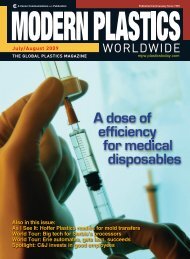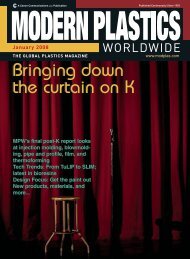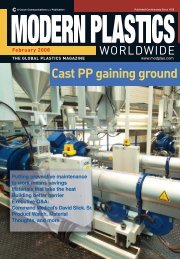amidiq - dae uptlax
amidiq - dae uptlax
amidiq - dae uptlax
Create successful ePaper yourself
Turn your PDF publications into a flip-book with our unique Google optimized e-Paper software.
262<br />
J. Manuel Loeza-Corte et al. / Revista Mexicana de Ingeniería Química Vol. 6, No. 3 (2007) 259-265<br />
phosphate buffer (0.2-0.1 M) at pH 5.6 and 30 °C<br />
during 96 h. The reaction was stopped by adding 1.8<br />
mL of Na2CO3 0.1 M. Quantification of L-arabinose<br />
was done as explained below.<br />
2.6 Quantification of L-arabinose<br />
The amount of L-arabinose produced was<br />
determined with an Agilent series 1100 high pressure<br />
liquid chromatograph (Palo Alto, CA), operated in<br />
the normal phase mode, fitted with a Rezex RHM<br />
monosaccharides column (300 x 7.8 mm, 8 μm;<br />
Phenomenex, Inc., Torrance, CA), and a refractive<br />
index detector (G1362A). Water was used as mobile<br />
phase at a flow rate of 0.4 mL·min -1 at 35 ºC. Peaks<br />
were integrated with the Agilent Chem Station<br />
software.<br />
2.7 Statistical analysis<br />
All experiments were done in triplicate and<br />
statistical analysis was carried out using the<br />
Duncan’s test with a significance level set at 5 %<br />
with the statistical software package NCSS (2001,<br />
Kaysville, Utah).<br />
3. Results and Discussion.<br />
The experimental data of the growth kinetics<br />
for A. niger 10 fitted well (R 2 = 0.9412) the logistic<br />
model (Fig. 1), with values of μmax of 0.07 h -1 and<br />
Xmax of 3.03 g L -1 . The lag phase was estimated as<br />
9.13 h from the fitted data. Comparison of our μmax<br />
and Xmax values obtained with A. niger 10 with those<br />
obtained with other strains of A. niger and other<br />
saccharides as substrates are given in Table 1. As can<br />
be seen, Xmax is highly dependent on the complexity<br />
of the saccharide used as substrate. The simpler<br />
saccharide, glucose, had a higher was Xmax (Favela-<br />
Torres et al., 1998). Pectin is a linear polysaccharide<br />
with a molecular weight ranging between 50 x 10 3 to<br />
180 x 10 3 Da (Pedersen, 1980), so that it is not<br />
surprising that A. niger Xmax for this polysaccharide<br />
(Díaz-Godínez et al., 2001) was better than that<br />
calculated for mesquite gum, which has a highly<br />
branched structure and an average molecular weight<br />
greater than 2 x 10 6 Da (Vernon-Carter et al., 2000).<br />
The behavior of μmax seems to be rather more<br />
complex than that of Xmax. The estimated value for<br />
μmax using mesquite gum as substrate was<br />
considerably lower than for pectin, but was<br />
practically the same as that for glucose. These results<br />
are difficult to explain in terms of the molecular<br />
structure of the substrates, and they seem to rather be<br />
a function of the microorganism employed which<br />
was A. niger 10 in the case of glucose and mesquite<br />
gum but was A. niger C28B25 in the case of pectin.<br />
Fig. 1 shows the fit of the α-Larabinofuranosidase<br />
crude extract activity data to the<br />
Soto-Cruz model (R 2 = 0.9738). Maximum activity<br />
was 65.93 U L -1 after 84 h of fermentation, which<br />
was used to carry out the hydrolysis of mesquite<br />
gum. The values for parameters α and β were 19.64<br />
U g -1 and -0.01 U g -1 h -1 , respectively. While the<br />
value of parameter β was near zero, the relatively<br />
high value of parameter α suggests that the activity<br />
of the crude extract was closely associated to the<br />
kinetic growth parameters of the mold.<br />
A. niger 10 concentration (g L -1 )<br />
Biomass<br />
Experimental value<br />
Fit to equation 1<br />
3.6<br />
3.0<br />
2.4<br />
1.8<br />
1.2<br />
0.6<br />
α-L-arabinofuranosidase activity<br />
Experimental value<br />
Fit to equation 2<br />
0.0<br />
0 20 40 60 80 100 120 140 160<br />
Time (h)<br />
Fig. 1. Growth kinetics of A. niger 10 using mesquite<br />
gum like carbon source and α-L-arabinofuranosidase<br />
volumetric activity obtained from A. niger 10 with<br />
different fermentation times. Initial pH = 5.6 and<br />
temperature of 30 °C.<br />
The specific activity obtained at 84 h of<br />
fermentation with the crude extract was 0.33 U mg -1<br />
of protein, while that the commercial enzyme<br />
reported in the data sheet (40 U mg -1 of protein) was<br />
121 times higher.<br />
The effect of temperature on the crude extract<br />
enzymatic activity is shown in Fig. 2. The highest<br />
activity occurred at 50 °C. This temperature falls in<br />
between the 46 °C reported by van der Veen et al.<br />
(1991) and the 60 °C reported by Kaneko et al.<br />
(1993) and by Gunata et al. (1990) as being optimum<br />
for α-L-arabinofuranosidase from A. niger strains.<br />
Table 1. Comparison of μmax and Xmax for Aspergillus niger using as substrate different saccharides<br />
Substrate Xmax (g L -1 ) μmax (h -1 ) Microorganism Reference<br />
Mesquite gum (10 g L -1 ) 3.03 0.07 A. niger 10 This work<br />
Glucose (100 g L -1 ) 12.00 0.08 A. niger 10 Favela-Torres et al. (1998)<br />
Pectin (15 g L -1 ) 4.38 0.22 A. niger C28B25 Díaz-Godínez et al. (2001)<br />
Pectin + sucrose (15 + 40 g L -1 ) 11.00 0.19 A. niger C28B25 Díaz-Godínez et al. (2001)<br />
70<br />
60<br />
50<br />
40<br />
30<br />
20<br />
10<br />
0<br />
α-L-Arabinofuranosidase activity (U L -1 )









